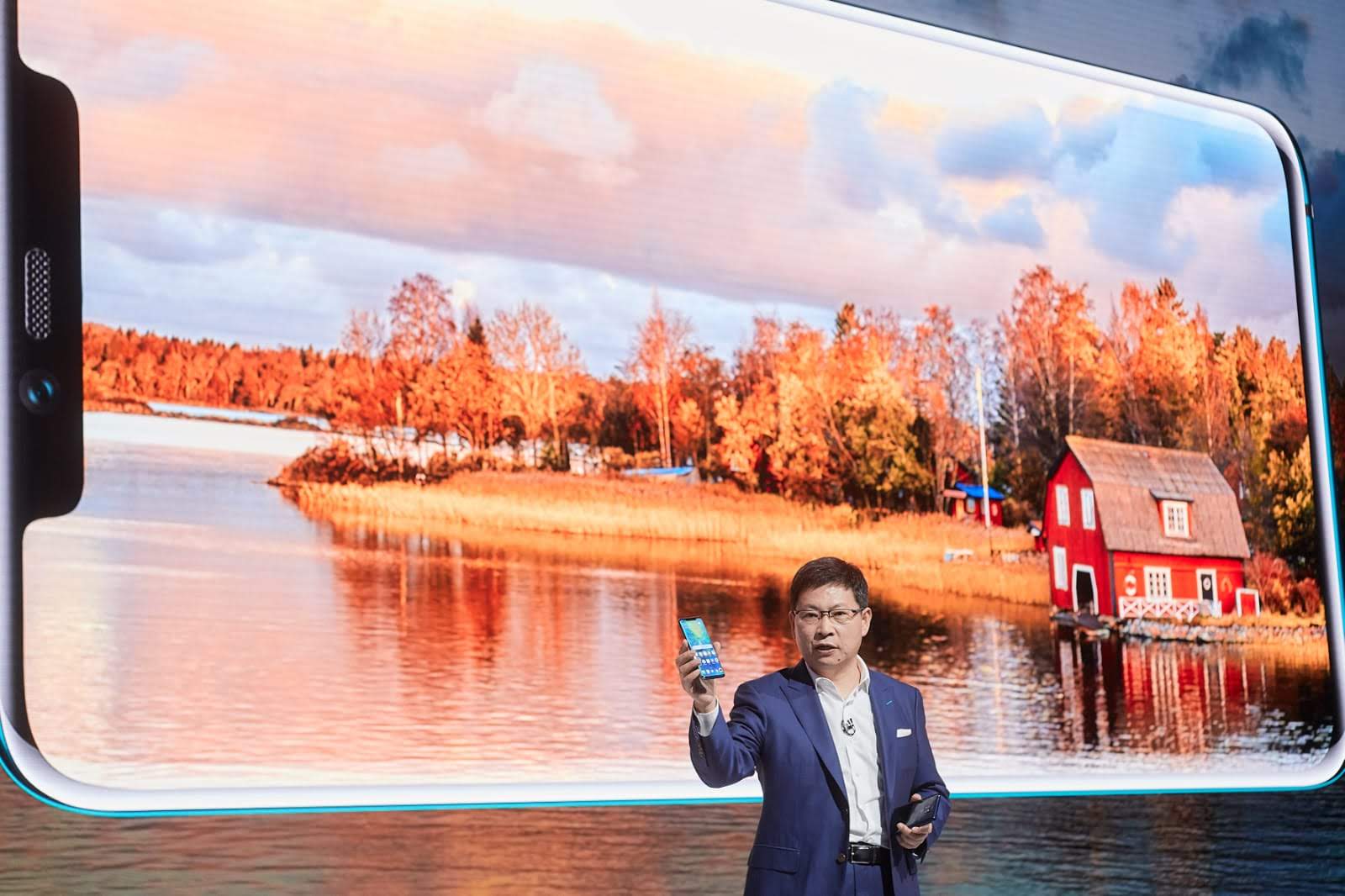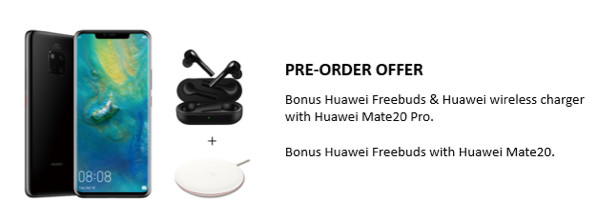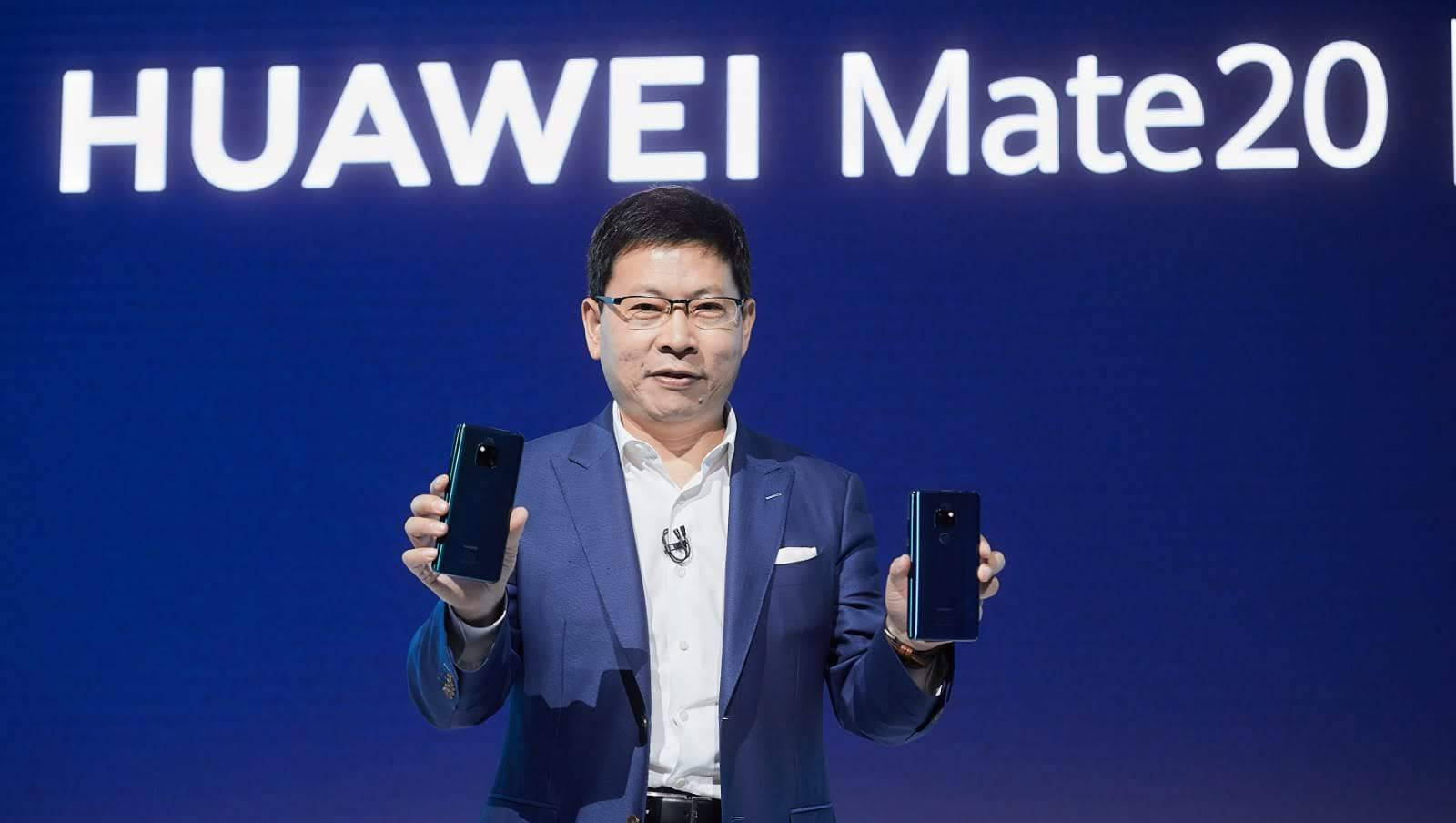A sizeable contingent of the Australian technology media is in London this week, for what is – arguably – one of the most exciting phone launches of 2018. After watching the smartphone space rapidly develop over the last eight years with increasing speed, it’s safe to say that we’ve become somewhat blasé about what constitutes “exciting”. This year, we’ve already seen so many excellent phone announcements, so why should Huawei’s Mate 20 announcement in October be so exciting as to be labelled as such?
Huawei has already had an impressive year; globally, the brand is the number #2 behind Samsung, having already toppled Apple. The brand has already announced the successful and eminently capable Huawei P20 Pro six months ago, and that phone was truly excellent. I don’t say that as some media shill who got a free phone and so raved about it – I actually went and bought my own, I was so impressed.
It is with that in mind that I’m here in London reporting on Huawei’s next phone, the Huawei Mate 20 Pro (and friends) … and I don’t think it’s a stretch to say that this phone is, objectively, better than the P20 Pro it succeeds.

What does Huawei’s Mate 20 Pro offer?
At its core, the Huawei Mate 20 Pro is powered by the company’s latest System-on-Chip, the Kirin 980 Dual AI 7nm processor. Much was made of this processor’s capabilities a couple of months ago at the launch at IFA 2018, and now that we’ve seen the real-world application of that chipset, let’s say I’m absolutely floored.
Blazing fast internals
Combined with 6GB of RAM and 128GB storage, you might think “eh”, but prepare to be surprised. We ran an AnTuTu benchmark on a demo unit, and before you say it, I know – benchmarks aren’t everything. However, with a score of 313,000 the Mate 20 Pro is easily 15,000 points clear of its nearest competitor, and that shows the raw speed (and lots of it) that this stunning phone has under the hood.
This translates to real-world application, too. Huawei’s Mate 20 Pro is fast. Really fast. App switching is instant. App launching is near instant. Every measure which a user perceives as fast or slow is in the fast category. Lag? What’s that.
Android Pie
Much of the seamless user experience comes from the combination of the Kirin 980 processor and Android 9.0 Pie; a match made in heaven, perhaps. I thought the P20 Pro was quick, and always believed that stock Android (the kind you’d find on a Pixel) was the fastest thing around. I think it’s possible that OEMs have figured out how to optimise Android better than Google’s own engineers, and I don’t say that lightly.
But performance is just one area, and it’s – unbelievable, I know – not the area that Huawei is really focusing on. They don’t have to – it speaks for itself.
No, the accolades are reserved for the Mate 20 Pro’s camera setup.
Tell me about the camera
Like the P20 Pro before it, Huawei’s Mate 20 Pro features a Leica engineered, three-lens array, led by a 40 MP sensor, paired with a 20MP and 8MP sensor as well. These are configured with the 40 MP sensor paired with a 16mm wide-angle, f/1.8 aperture lens, a 20MP ultra-wide f/2.2 lens for brilliant wide-angle shots, and an 8MP sensor with telephoto lens at f/2.4 aperture. This setup is not dissimilar to the P20 Pro setup, either, and Huawei is making much of what it’s learned in the last six months. In combination, these lenses allow up to 270mm zoom operation, back through to 16mm ultra-wide angle. That versatility in a smartphone is unheard of.
In short, it’s not hard to see why Huawei makes so much of its camera and advanced imaging AI; the results are simply (and in the most part, effortlessly) astounding.
Wide Angle Lenses with advanced zoom
These lenses work in conjunction to deliver a 0.6X wide-angle view that must be seen to be believed. There’s also 1X and 3X AIS (optical) zoom, and a 5X hybrid zoom that delivers incredible results from a combination of optical and digital zoom, the latter of which is almost always a bad phrase in photography. This allows you to capture more of the scene when you want to, and to get up nice and close when you can’t physically get closer yourself.
Unrivaled macro performance
The macro performance is something to be beheld; Huawei’s Mate 20 Pro can focus from just 2.5 CM from the lens, and this gives you incredible detail in all manner of things from insects, flowers, through to capturing details that the human eye cannot discern. Put it this way – Huawei’s Mate 20 Pro as not only able to make out individual pixels on my Lenovo Thinkpad X1 Carbon (something my eyes can’t do), but it was also able to reveal the colour configuration of the individual pixels.
Wow.
Night mode with a difference
With more advanced AI, Huawei’s camera app can automatically adjust to take the best photos in a range of environments, detecting clouds, blue sky, greenery, sports, plants, portraits and more with ease (and very quickly, too). The P20 Pro took some amazing photos of my family which I’ll forever treasure, and there’s little doubt the Mate 20 Pro will take even more.
Huawei’s night mode isn’t new; the P20 Pro featured it, too. However, it feels like it has really come along. Even without the “night mode”, it takes amazing photos light and dark.
Stay tuned over coming days when I take both these incredible phones on a tour of London and the Cotswolds AONB for a shootout.
What else do I need to know?
Huawei haven’t stopped at processor and camera with the Mate 20 Pro. There’s a huge 4,200 mAh battery that promises a couple of days’ battery life (or for me, a genuine full day), wireless supercharging as well as reverse charging – charge your other Qi-compatible gear with the Mate 20 on the go.
Moreover, there’s Dual 4G SIM capability, IP68 water resistance for selfies in the shower or the pool, and even a protective cover in the box, something that new users will well appreciate.
What remains to be proven?
There’s been a lot of noise in recent times about in-screen fingerprint sensors, and how they’ll free up more space for larger screens. I personally didn’t mind the below-screen fingerprint sensor on Huawei’s P20 Pro and found it extremely convenient for unlocking my phone on removing it from my pocket, on a desk, or even in the car to change songs. That miniscule amount of space it took up was a small trade-off for the benefit – almost-instant unlock every time.
With the Mate 20 Pro, Huawei has moved to an in-screen fingerprint sensor and while it is technically exciting, it’s one area of the phone that I’m not really excited about.
You see, there’s no way it’s going to be as fast or as accurate as a dedicated fingerprint sensor, and for me, that’s annoying. Yes, most of the time face unlock is going to get you there before fingerprint unlock does anyway, but there are times it won’t.
I hope the in-screen fingerprint sensor works as well as the hardware sensors do, and that it doesn’t represent a backward step. New technology is always a bit hit and miss, and I’m hoping this works out to be a hit.
Then there’s the elephant in the room.
Huawei aren’t afraid of the notch, and while the P20 Pro notch was restrained and fairly narrow, and allowed you to easily see notifications around it, the Mate 20 Pro has a wide notch, and makes the status bar virtually useless.
While it displays key information – battery life, cell signal strength, the time, WiFi / Bluetooth status – that’s where it stops. It’s a rare moment, from what we’ve seen, where notifications will actually be visible in the status bar, and this means that users will almost always have to swipe down to see what notifications have arrived. If you ask me, that’s a huge backward step, and one which may put off many users.
I would like to see Huawei offer, through a software update, an option to move the entire status bar below the notch so that users who expect and receive many notifications – like me – can usefully use this feature. Without it, using the Mate 20 Pro is going to take some getting used to.
Fortunately, the Mate 20 Pro has a slightly smaller brother (the Mate 20) which features a dew-drop display, meaning that almost all the status bar remains visible. This may make it the preferred phone, if for no other reason.
Huawei Mate 20 Pro and Mate 20 detailed specifications
Here’s the specifications for both Huawei Mate 20 series devices, side by side, so you can make an informed comparison between the two:
| Huawei Mate 20 Pro | Huawei Mate 20 | |
|---|---|---|
| Release date | November 1, 2018 | |
| Screen size | 6.39-inch | 6.53-inch |
| Screen technology | OLED | TFT LCD (IPS) |
| Resolution | 3,120 x 1,440 | 2,244 x 1,080 |
| PPI | 538 | 381 |
| Rear camera |
|
|
| Front camera | 24MP f/2.0 | |
| Chipset | Kirin 980 | |
| Core config |
|
|
| RAM | 6GB | |
| Storage | 128GB | |
| MicroSD | No – NM Cards (Proprietary) | |
| Battery | 4,200 mAh | 4,000 mAh |
| Battery removable | No | |
| Connector | USB-C 3.1 | |
| Headphone Port | None, via adaptor only | Yes, 3.5mm |
| Android OS | Android Pie 9.0 | |
| Vendor skin | EMUI 9.0 | |
| Dimensions | 157.8 x 72.3 x 8.6 mm | 158.2 x 77.2 x 8.3 mm |
| Weight | 189g | 188g |
| Colours |
|
|
Availability
Huawei’s Mate 20 Pro will arrive on 1 November 2018 in Australia, in two colours, on two carriers, and from a variety of retailers, as follows:
- Black colour
- Single SIM – available through Vodafone
- Dual SIM – available from JB HiFi, MobileCiti, Kogan and Harvey Norman
- Midnight blue
- Single SIM – available from Optus
- Dual SIM – available from JB HiFi, MobileCiti, Kogan and Harvey Norman
Huawei Mate 20 Pro will be available for outright purchase for $1,599.
Huawei’s Mate 20 is quite a bit cheaper, at $1,099, and will be available as follows:
- Black
- Single SIM – available through Vodafone
- Dual SIM – available through JB HiFi, Kogan and MobileCiti

From today, customers placing a pre-order will receive a bonus of Huawei Freebuds wireless headphones (valued at $199) with either the Mate 20 Pro or Mate 20, and Mate 20 Pro customers will also receive a Huawei wireless fast charger valued at $348. This promotion is an online exclusive, available through huaweipromotions.com.au.
Chris travelled to London with Huawei for the Mate 20 launch event.

























To buy this phone outright is silly its way overpriced but Optus have an $85 per month plan that includes this phone and fifty GB of data included data ,over two years this works out that you have paid about $1100 for the phone as opposed to $1600 outright .so it’s a very good plan with Optus probably the best around .I just pre ordered mine and includes the ear buds and wireless charger for pre ordering before nov 1.. great deal .
I’d love to preorder one of these, but can’t seem to find the twilight version for sale anywhere – despite seeing many reviews (web, YouTube etc) done with a twilight unit. Why is it so hard to find one in this colour? 🙁 Has anyone else here managed to find one yet? Cheers
They look like good phones , and a little better than last year with the questionable options list on the devices back then , still as they say , the grass is always greener 🙂 , We have to have something to sook about. I would have liked to seen the base mate 20 dimensions with the flat wide screen in the pro model spec at least as an option the skinny 18.9 aspect or whatever it is is not the premium choice for all of us . . The in display finger print sensor option seems a bit questionable… Read more »
pricing is really disappointing from huawei. They have always offered the Australian market very competitive pricing but not this time. Mate 20 – 1099$ = 850 euros 199/850 = 1.27
mate 20 pro : $1600 = 1050euros 1600/1050 = 1.52 how does this make any sense?
Any word on if Optus is going to be updating this more than every 5 months? My mate 10 Pro has gotten 3-ish updates in nearly a year.
Not impressed.
One thing we’ve found this year is that, with the P20 series at least, software updates have been much more frequent, albeit a little slower than with some other brands. We’re expecting – but it’s not been explicitly stated – that the Mate 20 Pro will adhere to this more frequent updates schedule. Unsure how this will flow through the carriers, and I suspect that’s more up to them than any OEM (Huawei or otherwise).
My phone is from Optus, Huawei have released updates pretty consistently, but Optus have been awful in passing them on.
Doesn’t the non-pro have a headphone port? The table says it does not.
Turns out the press release we had earlier – where this information came from – was incorrect. The non-pro variant does, indeed, have a headphone jack.
No twilight colour by the looks.
Word on availability of proprietary storage card?
There will be a twilight variant and it looks amazing… However it doesn’t look like it’ll be coming to Australia. We’ve not got official word on the NM card availability at this stage, but pricing we’ve heard $130ish for the 128GB card.
Any news on Mate20 X availability here?
Yep – not coming at this stage, but Huawei are still considering it basically.
Nah, pass (and I say that typing from a Mate9)
Too big, too expensive, no headphone jack. Solid pass from me.
The price has definitely jumped up, but you do get an awful lot included for your money. It’s just a question of whether it’s worth it for you .. and for many, at $1,599 – it may not be.
in china it was announced that the mate 20 pro was 5400rmb so only 1100 aud. Terrible australian pricing. if they priced it at 1450, it would sold very well
Do we get the Mate 20 only in 6gb variants, or is the 4gb variant going to be floating around?
I like the Mate 20 Pro but I think the Mate 20 is better value, given you get most of the main features for $500 less.
Only variants coming to Australia are 6GB/128GB. No other models were mentioned in the presentation nor the press releases.
Mate 20 x not coming to Australia? It makes more sense I guess.. Same camera and internals for lesser price and a bigger screen.?
The information we have thus far suggests no, it won’t be at this stage, but Huawei does monitor demand and market conditions etc and may ultimately do so down the track, but Australia definitely isn’t a launch market.
Sounds like a great phone but is the pricing a bridge to far? 50 odd percent more expensive than the P20 pro and more expensive than a Note 9.
I don’t think the average consumer will walk into jb’s and cross shop it against the iPhone or something from Sammy or Google at these prices.
Everyone has their own views on notches, and I’m not without mine. However, one thing to note – this is a launch post, not a review. There are definitely negatives to the Mate 20 Pro’s notch – it’s wide enough that it does obscure notification icons and this is a usability problem. That said, it’s a minor issue, and as with most phones, it’s a trade-off. There are plenty of other phones with smaller notches that simply aren’t great phones, notch or not. However, there will be definite criticism of the notch on the Mate 20 Pro, and when the… Read more »